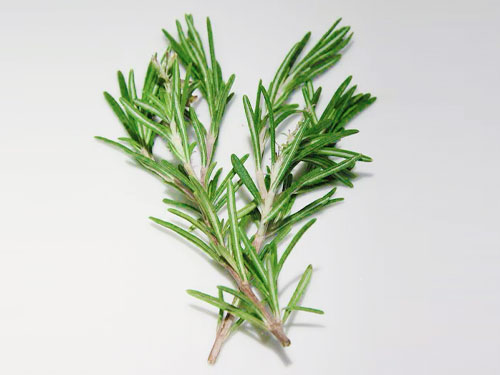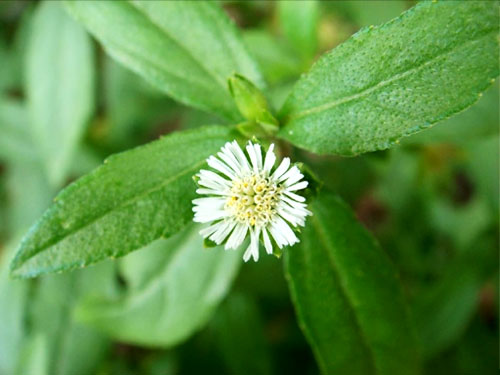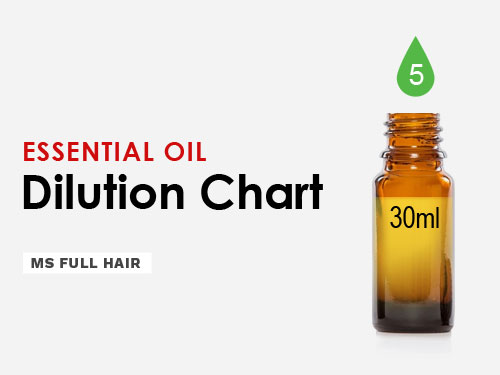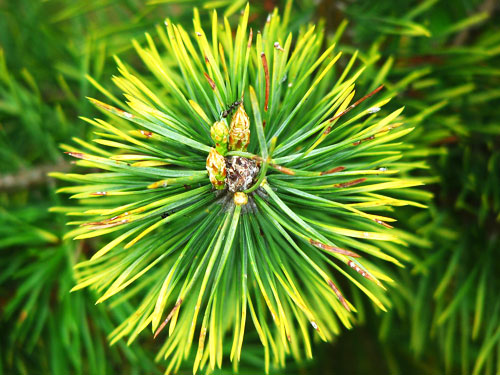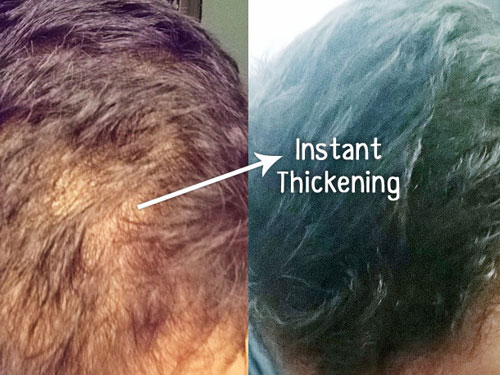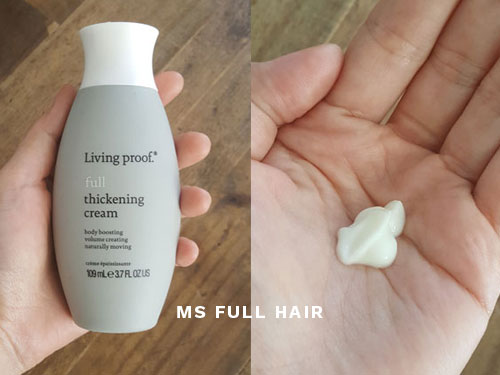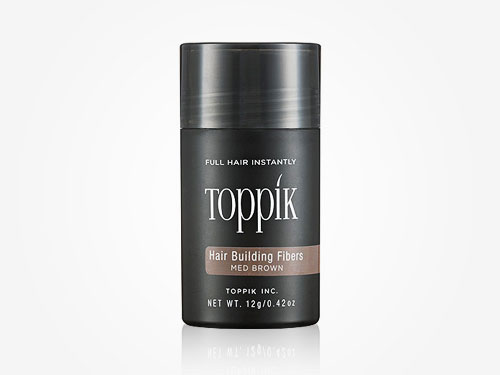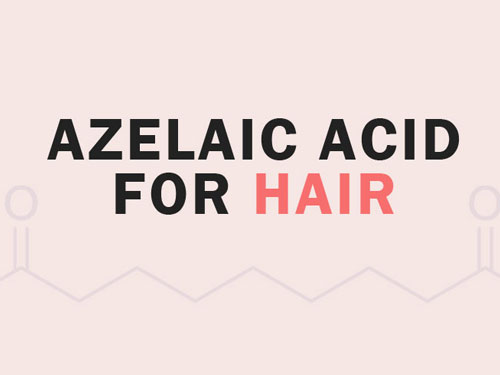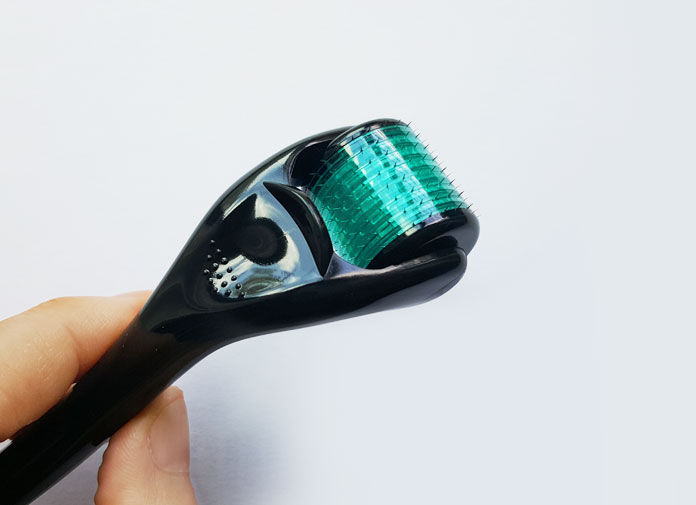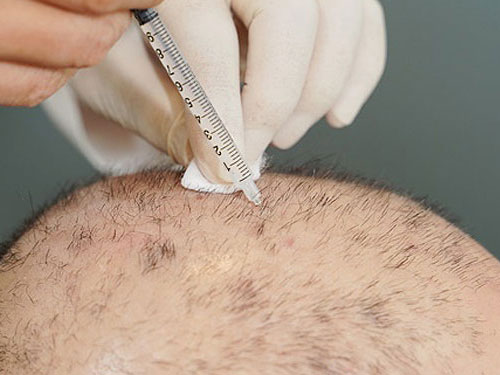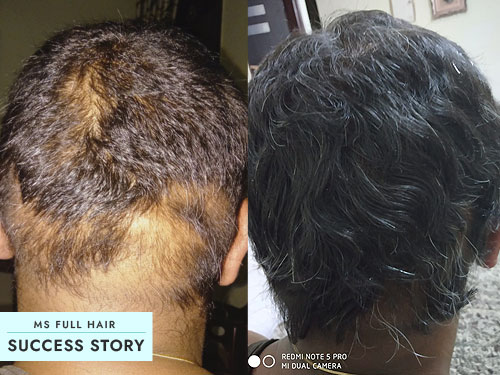Azelaic acid (AzA) is a popular ingredient used for treating acne.
But studies show that you can actually use azelaic acid for regrowing hair! Even better, azelaic acid even appears to work for alopecia areata – one of the toughest causes of hair loss.
In this article, we will cover top benefits of using azelaic acid and how it can help with stopping hair loss.
First, let’s go over the basic:
What is azelaic acid?
Azelaic acid is a naturally occurring compound found in grains such as wheat, barley and rye.
In humans as well as animals, azelaic acid is a naturally produced substance by Malassezia furfur, a fungus/yeast living on the surface of the skin.
Azelaic acid has a molecular structure of C9H16O4.
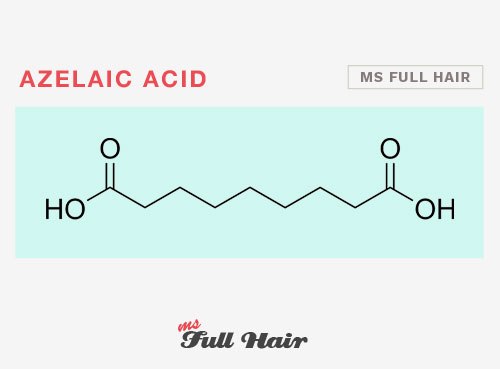
Do you see the chemical chain has 2 COOH on each end? This makes Azelaic acid a part of saturated dicarboxylic acid family and gives the appearance of a white powder.
Azelaic acid you see on the market is manufactured by synthesizing a natural compound. It uses an oxidizing reaction to convert the natural compound’s oleic acid into azelaic acid.
What are azelaic acid benefits for hair and skin?
Azelaic acid contains multiple beneficial properties from anti-inflammatory, antioxidant, anti-bacterial and keratolytic agents. All these properties effectively work together to make azelaic acid an unique and effective treatment for various hair and skin conditions.
It reduces excess build-up from skin and scalp and reduces and soothes inflamed pores. Plus, it doesn’t have any major side effects.
Azelaic acid is anti-inflammatory
Azelaic acid is also known as “a scavenger of free radicals.” It has an inflammation reducing property, so topical creams that contain azelaic acid are used for treating symptoms such as rosacea.
Azelaic acid is antibacterial
Azelaic acid inhibits bacteria from infecting the pores of the skin – this especially works well for acne-prone skin.
Azelaic acid is keratolytic (or anti keratinizing)
Think of keratolytic as a peeler. It removes excess layers of dead skin cells (keratin) and residues from the scalp (skin).
This is how keratolytic (keratinization) process works:
Our epidermis (the outer layer of skin) goes through a keratinization process. It first starts from the division of our skin cells (which is always in constant motion). As the cells constantly divide, the outer cells get pushed outwards and last about two weeks.
Azelaic acid reduces the excess buildup of these dead outer skin cells, which in turn decreases the chance of inflammation due to unwanted bacterial growth.
This also explains why azelaic acid is also used as an effective solution to treat fungal induced scalp symptoms such as dandruff and dermatitis.
Azelaic acid is a 5a reductase inhibitor (thus stopping hair loss and helping with regrowth)
A study found azelaic acid’s ability to lower DHT levels on the scalp. The researchers also noted its increased effectiveness when used with zinc sulphate.
Another study shows that azelaic acid is as effective as anthralin – a topical cream used to treat alopecia areata (patchy baldness).
Below shows detail on each study.
Azelaic acid for hair growth studies
Study 1 Azelaic acid for regrowing hair on alopecia areata participants
This one is interesting.
A 2005 study published in American Journal of Clinical Dermatology shows promising results of using Azelaic acid for treating alopecia areata.
Alopecia areata (AA) is spot baldness where one or more small and roundish bald patches appear on the scalp. Many people usually get a bald spot on back of head. The scientists believe AA is caused by autoimmune disease (Read what medical medium says about the REAL reason).
In this pilot study, the researchers wanted to find out the effectiveness of using azelaic acid in people with alopecia areata.
How was the study designed?
This study included 31 participants all with alopecia areata (patchy hair loss). The researchers confirmed the participants were clean from receiving any other treatments at least one month prior to the study.
The participants were then randomly divided into two groups
- Group 1: 20% of Azelaic acid cream
- Group 2: 0.5% of Anthralin cream (topical cream used for alopecia areata)
What is Anthralin? Anthralin cream is a topical medication mainly used for treating psoriasis on the scalp. Anthralin (also called Dithranol) is a man-made form of what is naturally found in araroba tree.
The active compound helps slow down the growth rate of skin cells, thus reducing ongoing dead skin build-up such as flakes and layers of dry patches from the scalp.
Anthralin is also used to treat alopecia areata, but you need a prescription from a dermatologist. You use anthraline as a topical application by applying on the bald areas once a day.
Duration
The study lasted for 12 consecutive weeks.
How was it measured?
The independent team performed a clinical evaluation by using a terminal hair regrowth (normal thick hair) score at week 20. This is the scale used for measurement.
- 0: inadequate/no response
- 1: partial response
- 2: complete response
What was the result?
Group 1 (treated with 20% of azelaic acid topical cream) showed 1.27 +/- 0.9 , while the other group (1.5% anthralin cream) had a result of 1.37 +/- 0.8.
The researchers also shared complete response rates as described in the percentages below:
- Group 1 (Azelaic acid): 53.3%
- Group 2 (Anthralin): 56.2%
What does the result mean?
First, both groups showed positive results – More than half in each group experienced hair regrowth.
Also, the response rates are in the similar percentage range, which indicates that both azelaic acid and anthralin have similar efficacy rates for treating alopecia areata.
In other words, using 20% Azelaic acid for hair loss can be as effective as anthralin topical cream.
Were there any side effects?
No major side effects were reported.
Where can I find 20% azelaic acid for hair loss?
Most products that are sold over the counter contain up to 10% azelaic acid concentrations. But we managed to find this topical cream which contains 20% azelaic acid.
Study 2 Azelaic acid for androgenetic alopecia (aka DHT hair loss)
This vitro study (2) published in the British Journal of Dermatology in 1998 shows the importance of using zinc and azelaic acid for inhibiting 5a-reducatase activities.
5a reductase is an enzyme that converts testosterone into dihydrotestosterone (DHT), which is the culprit of follicle miniaturization and overall thinning.
In the study, the researchers observed some interesting findings:
- Zinc sulphate inhibits 5a reductase activity. At higher concentrations, (9mmol/1), it totally blocks the activity of the enzyme
- Azelaic acid also works similarly to zinc sulphate, even at lower dosages (0.2 mmol/l). At higher concentrations, azelaic acid also completely inhibited the activity of 5a reductase.
- When combining Vitamin B6, zinc, and azelaic acid, this mix created an amazing synergetic effect even at very low concentrations and blocked 90% of 5a reductase activities.
What does the result mean?
Zinc is nothing new when it comes to promoting proper hair growth. So while there’s no surprise here, the study once again confirms the importance of this powerful mineral element.
What’s interesting about this study is that even at low concentrations of azelaic acid, the researchers were able to observe the inhibition of 5a reductase enzyme.
This explains why quite a number of people with androgenic alopecia often use minoxidil solutions that contain azelaic acid.
Azelaic acid minoxidil solution – Combining 2 DHT hair loss blockers
One of the most popular ways people with thinning hair seem to use azelaic acid is to mix with minoxidil.
Using azelaic acid and minoxidil together:
While above studies show somewhat promising results, many people don’t appear to use azelaic acid alone. From what we’ve found on various forums, reviewers use azelaic acid and minoxidil to combat hair loss.
One of the reviewers (3) from hair loss talk forum says that he experienced much better results using minoxidil azelaic acid combination. He previously used Rogaine foam and also tried the azelaic acid cream alone. For him, using the azelaic acid cream alone on a regular basis was too impractical.
He says his current minoxidil formula that contains 5% azelaic acid and retinol makes his hair feel a lot thicker and reports greater hair regrowth.
The most common ratio appears to be 15% minoxidil with 5% azelaic acid among men.
There are two companies who sell this solution: One is xandrox (from Canada) and minoxidil laboratory. We are not familiar with either company, so talk to your doctor first. Also this solution is mostly used by men. We haven’t found any reviews from women using such strength.
Note that the FDA-approved “over-the-counter” minoxidil strength is 5%, so 15% minoxidil solution is not readily available, unless prescribed by a dermatologist.
Azelaic acid vs finasteride for hair loss
Finasteride, also known as propecia, is a medication for male pattern hair loss.
Both azelaic acid and finasteride do the same thing – inhibit 5a reductase enzyme activities from increasing DHT hormones in the scalp.
There are two differences between azelaic acid and finasteride:
Topical vs oral: Finasteride is an hair regrowth medication that is orally taken, while azelaic acid is a topical treatment that comes as a gel, ointment, or cream.
Finasteride is not FDA approved for women, even though there are some cases of women also using it for the purpose of regrowing hair.
But when you look at the results, it’s very mixed.
Two studies show that women who took finasteride actually continued losing hair, while another study we came across says it gave overall improvements in hair density in most participants.
However, even if it worked for some women, the side effects are very concerning – including birth defects and liver damage. Because of this, it is probably best for women to avoid using it.
Bottom line: When comparing azelaic acid and finasteride for treating female hair loss, azelaic acid is a much safer option.
Any side effects using Azelaic acid for hair loss?
The topical use of azelaic acid is considered to be safe. Some people experience itching and burning sensations, but with continuous use, such symptoms dissipates.
Azelaic acid for hair loss – What products include azelaic acid?
If you have alopecia areata:
If you are trying to use azelaic acid for alopecia areata (just like the study), this one is the only topical cream that we found with a 20% concentration.
If you are using azelaic acid for thinning hair (androgenetic alopecia):
Serum: If you are using azelaic acid for stopping hair loss and regrowing hair, check out this hair growth serum. It contains azelaic acid, green tea extract and B vitamins, and the serum is specifically formulated for hair regrowth in both male and female pattern hair loss.
Shampoo: If you are looking for azelaic acid shampoo (which is surprisingly NOT easy to find), try Revivogen MD shampoo. Revivogen is a well-established brand among people suffering from hair loss.
While their scalp therapy serums are a bit pricey, this shampoo is reasonably priced compared to other hair loss shampoos. Revivogen MD shampoo contains a number of DHT blockers including azaleic acid and saw palmetto extract, along with jojoba oil and aloe vera.
Have you used azelaic acid for thinning hair? Would love to hear your experience!


